A member of the Felidae family, the leopard is one of the five extant species in the genus Panthera. It is found in various parts of the planet including the Indian subcontinent sub-Saharan Africa, Southeast, East, Western, and Central Asia. Due to habitat loss and fragmentation, the number of leopards has been drastically reduced in many countries which made this species listed as Vulnerable in the IUCN Red List.
If you observe the leopards closely, you will see that this species has made itself quite familiar with human beings and the sighting of this species is very easy here. If you compare leopards with the other species of big cats, you will find its appearance very similar to the jaguar and may not even be able to differentiate between the two.
If you search the differences between the two then you will find out that the former has a lighter and a smaller build along with shorter rosettes as well. Leopards are known for their stealthy and opportunistic hunting behavior, agility, strength, and ability to adapt to different environments. Because of this, leopards can be found in different habitats includes alpine regions, arid steppes, and rain forests as well.
They even take the carcass of their hunt up to a branch of the tree and eat it cautiously because, in the ground, they are mostly pestered by the packs of wild dogs and hyenas. Because of their smaller size, they are no match for a lion or a tiger, therefore, leopards also keep themselves out of the areas of bigger-sized cats. If you look at the history of this species, it is estimated to be 600,000 years old as per the fossils found in Europe and Japan.
How Many Types of Leopard in India
In India, There are four types of leopards found, named as Indian leopard, snow leopard, clouded leopard and black panther.
1. Indian Leopard– Widely dispersed in the Indian subcontinent, this subspecies has shown an increase in the number in its native land due to the efforts of government and environmentalists. As per the survey conducted in 2014, the total number of leopards in India is estimated to be around 12,000 to 14,000.
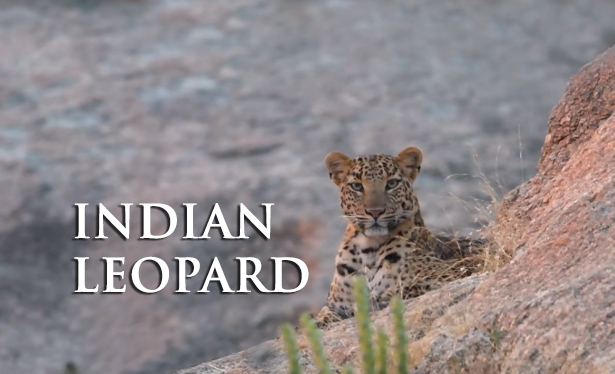
The scientific name of the Indian leopard is Felis fusca and it has light grey ocular bulbs on its body along with yellowish-grey eyes, short ears, broad muzzle, strong legs, and a well-formed tail. They are also found in their melanistic versions in some wildlife reserves in the country. The young ones have woolly fur unless they reach adulthood.
Their tale can grow 24 to 39 inches (60 to 100 centimeters) long and the rosettes are highly conspicuous on the hindquarters, flanks, and the back. The color of the fur depends on the habitat of the leopard, if it exists in colder climates then it is grayer and if it in an arid region then the fur color gets pale.
If you talk about size, males usually grow somewhere between 4ft 2in (127 cm) to 4ft 8in (142 cm) tall with the weight range of 50kg to 77kg. Females have a smaller build that is between 3ft 5in (104 cm) to 3ft 10in (117 cm) in height and the weight range is between 29kg to 34kg. The leopards are sexually dimorphic and therefore, males have a heavier and larger build than the females.
2. Snow Leopard– In India, this subspecies is found in the Himalayan region, the other places where it is found are the mountain ranges in South and Central Asia. It is usually found at the elevation of 3,000 to 4,500 meters (9,800 to 14,800 ft) and its habitat is shrinking because of the increasing infrastructural developments and poaching in the alpine regions.
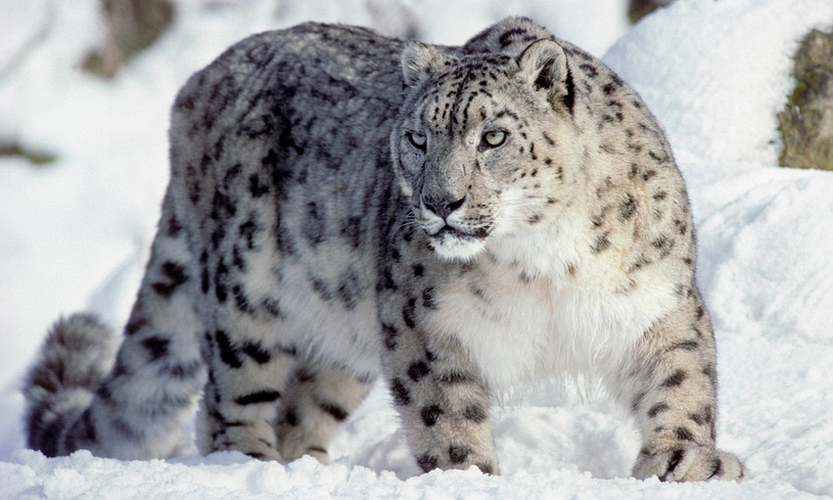
The snow leopard is a monotypic species which means that it does not have any other subspecies. A few zoologists cum naturalists gave different names this subspecies, Johann Christian Daniel von Schreber called it Felis uncial in 1777, Christian Gottfried Ehrenberg termed it Felis irbis in 1830, and Thomas Horsfield proposed Felis uncioides in 1855.
Upon looking at the phylogeny of snow leopard, you will find out it probably diverged from the tiger in its evolution around 3 million years ago. If you talk about the characteristics of its body, its fur grows from to whitish to gray with black spots. The tail is bushy with larger rosettes on flanks, back, neck, and head.
Any clear image of a snow leopard will tell you that it is smaller in size compared to the other big cats. The legs are short, the body is stocky, and the fur is thick with hair sized between 5 and 12 cm. A male usually weighs between 22 to 55kg and the female could weigh between 20 to 50kg. Its nasal cavities have grown broader and ears are small and rounded after millions of years of evolution.
3. Clouded Leopard– The clouded leopard is actually a medium-sized cat that is found in the Himalayan foothills and some other regions including southern China and Southeast Asia. Like the snow leopard, this species also got multiple names, Felis nebulosa by Edward Griffith in 1821, Felis macrosceloides by Brian Houghton Hodgson in 1841, Felis brachyura by Robert Swinhoe in 1862, and Neofelis by John Edward Gray in 1867.
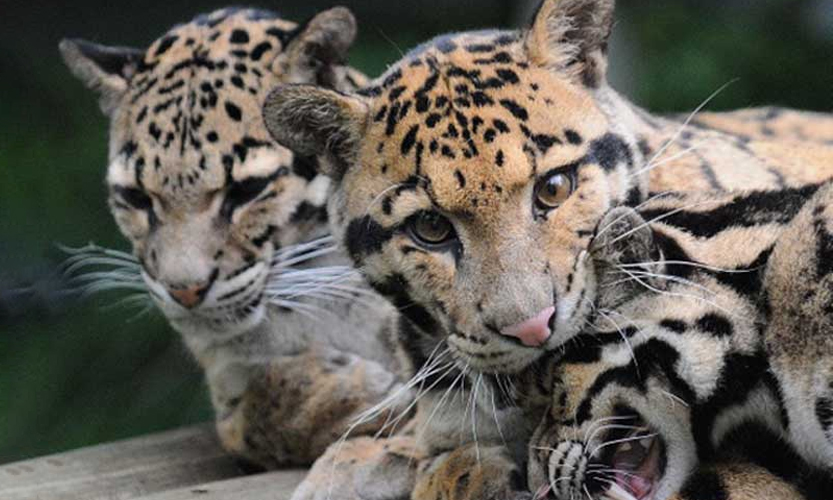
As per the phylogenetic analysis, clouded leopard diverged from the Panthera approximately 6 million years ago but they are not related to the leopard at all. However, this species has evolutionary links with the Felinae and Pantherinae family.
As far as the characteristics are concerned, its fur has a dark dusky-grey blotched pattern with ground-color and often black-color hue. On the head and ears, you can see black spots while on the body, there are broken-up stripes.
There are single median stripes on the loins with elongated blotches, the tail has irregular spots as well. The clouded leopards (male and female both) weigh between 11.5 kg and 23 kg, when you at length and other features, you get to see some sexual dimorphism.
Their canine teeth are quite prominent and it almost three times the height of the socket which has earned it the title of “modern-day saber-tooth”. In India, they are found in the northeastern states such as Arunachal Pradesh, Nagaland, Assam, Nagaland, Manipur, Mizoram, Tripura, Sikkim, and West Bengal.
4. Black Panther– It is a melanistic color variant of any Panthera. In Africa and Asia, they are referred to as black leopards and in the Americas, they are commonly known as the black panther. In India, you obviously get to see the leopard variant and they are found in quite a few wildlife reserves, however, very rarely seen.
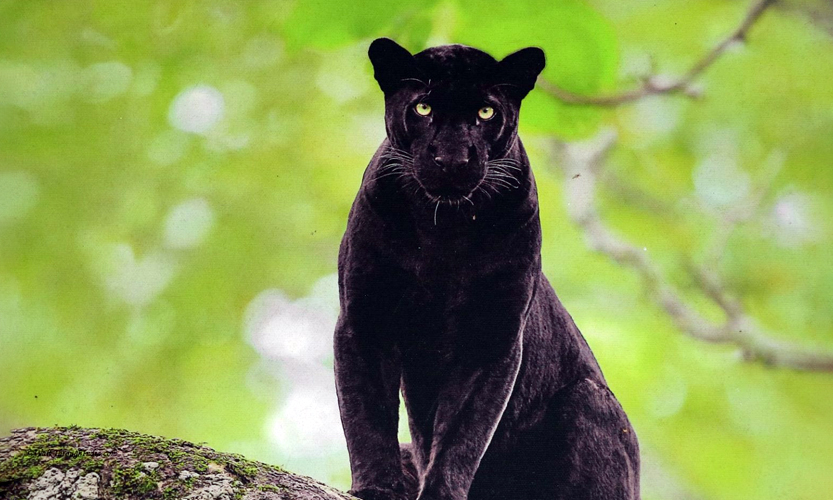
Those who are interested in knowing the reason behind the black pigmentation, it is caused by recessive allele in the leopard which is a genetic attribute. Their colors and features make them very noticeable and also very attractive to the spectators. In India, they are found in various national parks and wildlife sanctuaries where other big cats are also present.
Other than melanism, the rest of the features are the same in the melanistic and non-melanistic versions of the leopard. In terms of size and weight, they are the same and the hunting habits are also the same. In the Nagarhole national park of India, the black leopards are often spotted and a large number of tourists come to see them.
In most of these leopards, the rosettes are not visible at all, however, in some of the reserves, rosettes have been seen on the bodies of melanistic jaguars and leopards. Most of the time, the black leopards of India have a jet black color throughout their body. It makes them almost invisible in the night time and helps them in the nocturnal hunt massively.
Leopard – About Leopard Habitat, Diet, and Interesting Facts
About Leopard– With a broad muzzle, strong legs, and a well-formed tail, the Indian leopard is a formidable predator. We have already discussed its size and color above. If you particularly talk about its skull, it weighs around 1000g (2 lb or 4oz) and is 7.9 in (20 cm) in breadth, and 11.2 in (28 cm) in basal length. In comparison to the skulls of some other subspecies, it has subtle differences.
Habitat– Leopards are highly adaptable and because of this attribute, they can be found in various terrains across the globe. From mountains to deserts, you can find them anywhere, however, a large number of leopards are found in dense forests and they are mostly seen perched on some tree. They do that for keeping themselves from other predators like hyenas, wild dogs, and other big cats of larger size.
Diet– They are carnivores with a broad dietary spectrum and hunt all types of animals including bovines, deer, ungulates, games, and even dogs. Unlike tigers and lions, leopards don’t totally depend on brute strength for a kill, they are stealthy in nature and this enhances their chances of success in the hunt. It is a wonderful experience to see leopards killing its prey because they exhibit great intelligence while hunting and even in keeping their food safe from scavengers.
Interesting Facts–
? Although they look smaller in size as compared to other big cats, they are exceptionally strong.
? A leopard does not just kill a prey bigger in size and weight, it also takes them to the high branch of the tree so the scavengers cannot seize the food in any way.
? Also known for their agility, a leopard can run on an average speed of 58km/h. It can also jump 3meters vertically and 6meters horizontally.
? They solitary beings and mostly hunt alone, they leave claw-marks on trees and urine to demarcate their area.
? A prominent character in Rudyard Kipling’s “The Jungle Book” is Bagheera, who is a black leopard.
? The maximum number of human-big cat conflicts involves leopards because they come closer to human settlements very easily.
? Jim Corbett is a renowned hunter-naturalist who killed many man-eating leopards and tigers in the Kumaon region of India and penned a book about it as well.
? In 2014, a leopard named “Ajoba” was featured in an eponymous Marathi feature film. His journey from Mumbai to the Western Ghats was filmed and exhibited on the silver screen.
? Leopards have surprised the zoologists, environmentalists, and spectators a number of times with their behavior. In a footage released by National Geographic, a leopard was seen killing a baboon who had an infant clung to its chest. The leopard did not the infant, on the contrary, it cuddled and took care of him for a very long time. In another footage, we see a leopard cuddling a young deer and not killing it.
Difference Between Leopard, Cheetah, and Jaguar
People often get confused with different species of big cats and the only ones recognizable to them are tigers and lions because of their highly-prominent features. Before we begin, let us exclude one name from the list and that is ‘Panther’. That’s because it is more like an umbrella term for various big cats belonging to a different genus. Here’s a list which would help you remember the difference between these subspecies:-
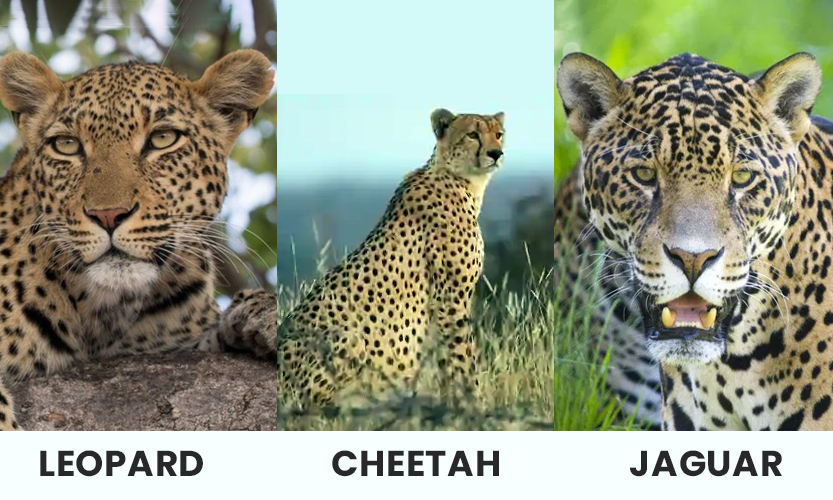
| Classification | Leopard | Cheetah | Jaguar |
| Kingdom | Animalia | Animalia | Animalia |
| Phylum | Chordata | Chordata | Chordata |
| Class | Mammalia | Mammalia | Mammalia |
| Order | Carnivora | Carnivora | Carnivora |
| Suborder | Feliformia | Feliformia | Feliformia |
| Family | Felidae | Felidae | Felidae |
| Subfamily | Pantherinae | Felinae | Pantherinae |
| Genus | Panthera | Acinonyx | Panthera |
| Species | P.pardus | A. jubatus | P.onca |
There are a total of 9 categories under which the big cats are classified. If you notice, the first six classifications (in descending order) have the same captions for all the three big cats on our list. The major differences lie in three categories which are subfamily, genus, and species. You must have also noticed that the columns of leopard and jaguar only have one different entry which is ‘species’.
Thus, if you now see the images of leopards and jaguars, it would make sense to you. Cheetah has three different attributes from the other two look-alike species and as a result, it is actually a unique-looking big cat with a slender body, thin legs, and a small but protruded skull. Both jaguars and leopards are opportunistic hunters, they can easily adapt to different habitats.
Cheetahs, on the other hand, are the fastest land animals and are mostly found in Africa and Central Iran where there are vast steppes as chasing is an indispensable element that they use for hunting their prey. Jaguars and leopards are mostly found in dense forests, however, their adaptability has enabled them to become a successful hunter in mountains and deserts as well. All these species have taken millions of years to evolve and they have made themselves apt for their native places.
Seeing each of these species in their natural habitat is an exquisite experience and that’s the reason thousands of people choose to do a wildlife safari in different regions all over the world. We can certainly say that leopards have shown some exceptional adaptable skills as they can be found in dense forests of Asia, steppes of Africa, and alpine regions of Himalaya as well.
Here’s a small video of “leopard vs. cheetah fight” that you will surely enjoy:
Somethings About Jawai Leopard:
This is a place that gives a unique setting to this species of the big cat, here, you get to see them living in natural caves inside the granite hills. Most importantly, the sighting of leopards is very easy, you don’t have to roam about for hours to get a glimpse of the big cat which happens in many national parks and sanctuaries.
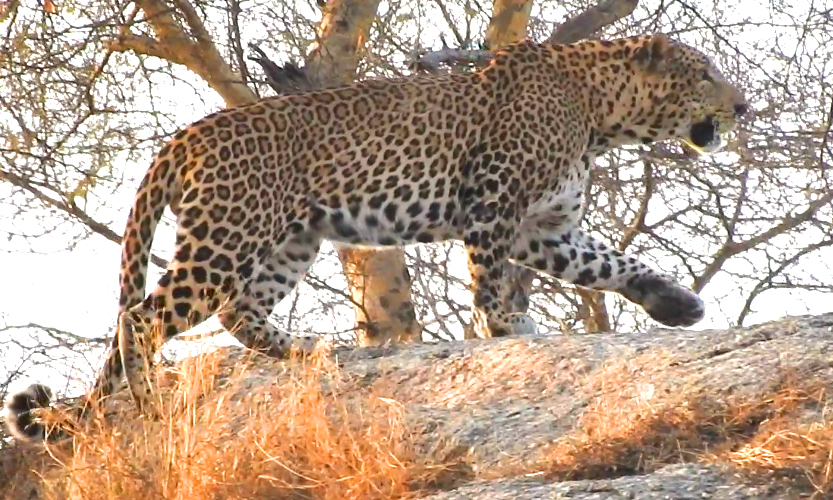
In Jawai, leopards have been living near the human settlements for decades now and there hasn’t been a single human-animal conflict in this place. You will be surprised to know that the locals living here belong to the Rabari tribe and cattle-rearing is the principal part of their earning and they often have to take their cattle for grazing into the forests.
Anyone would think that there is a huge risk in taking the cattle into the jungle where leopards are all set to ambush the herd, but that does not happen in Jawai. Here, if an animal is accompanied by a human, then you cannot expect an attack from the leopards. If you don’t believe it, then you should come to this place and see the shepherds take their livestock to the jungle.
The leopards do attack the cattle but only in the night when they are not with their caretakers. Due to this, the big cats have earned the respect of locals and are even considered the guards of their deity. Seeing a leopard in Jawai is an exciting experience that one wants to recall time and again. There are also some hill temples in this area that are frequented by humans and leopards both.
Once you are here in Jawai, you get mesmerized by seeing the familiarity of leopards with humans, you might even think that these wild animals can even be domesticated.
Furthermore, there is a lot more than one species that this place offers to see. You also get to see a great variety of migratory birds along with hyenas, jungle cats, nilgai, foxes, wolves, sloth bears, and many other animals.
The landscapes of this place are truly breathtaking and one may never stop taking stills of this region. At this place, you get to explore an unseen side of India’s wildlife, you get to the depths of wilderness and experience the most thrilling moments of your life.
Final Words
Jawai is a place where you get amazed by seeing the closeness of wildlife and humanity, it is a place that encourages you to do Jawai leopard safari and to delve deeper into it.
Thour Nature Resort is a resort property dedicated to bringing people closer to this land and we do it with a thrilling safari ride and the luxury tent that is built to give you a feel of comfort and gratification. With us, you can make the most of your tour to Jawai and see the real beauty of this place, you get to experience the most adventurous trip of your life with us.
If you want to see this splendid animal then come to Jawai and book your safari with Thour and enjoy this adventurous tour to its fullest.
Book Your Secure Trip to Jawai Bandh, Rajasthan With Thour Nature Resorts Call & Whatapp :+919784559999 | Email: [email protected] ? ?








